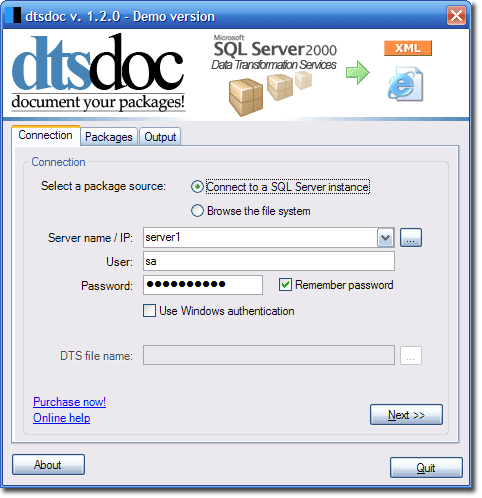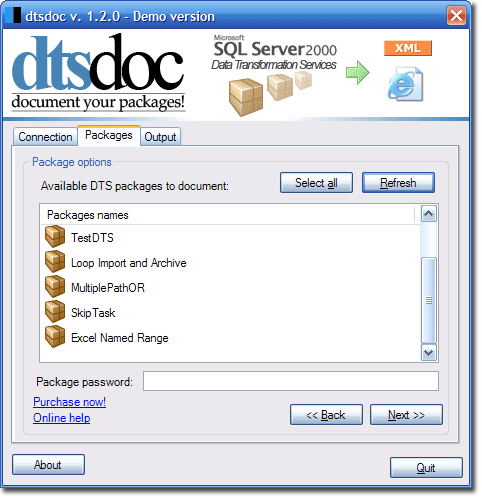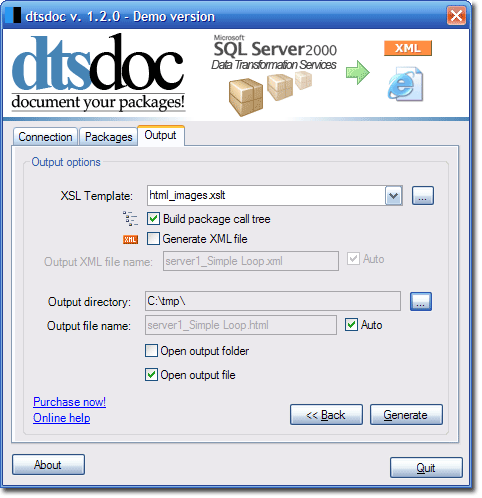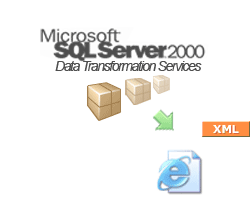User guide
Wizard interface
Once dtsdoc has been installed you should have a new icon like this
 in your desktop. Double-click on it to launch dtsdoc.
in your desktop. Double-click on it to launch dtsdoc.
There are three tabs (connection, packages and output) where you can set the some options.
Connection options
Package source: The first you need to specify is where your packages are located. dtsdoc can document DTS packages that are stored on a SQL Server instance or directly in the file system with the structurated storage format.
Server name / IP: In this field you must type the server name or ip address where the DTS packages are hosted. If the database is hosted locally you can leave this field empty.
Next to this field there is button to auto-discover SQL Server instances in your network. dtsdoc will try to populate a list with all the reachable SQL Server instances. Note that this can take a few seconds or even fail depending of your firewall settings.
User and Password: Type here the user and password that dtsdoc will use to connect with SQL Server. Note that to perform some queries dtsdoc must have administrative privileges over the server, therefore you will usually use the admin account: sa for SQL Server.
Use Windows authentication: Use your Windows user account to connect with the server.
DTS file name: Type or browse the DTS file.

Packages
In this tab you can retrieve the list of available packages and select one to document.
Once the connection options are setup, just press the Refresh button and select a package to document.
You can document various packages at the same time. To select multiple packages just press control key and select the packages.

Output options
This tab allows you to choose between different output options.
XSL templates
XSL template: In this combo you have a list of the default XSL templates that dtsdoc includes. However you can select your own templates clicking in the right button and selecting them from the file system.
Build package call tree: Check this option to generate a package call tree image. dtsdoc will navigate through the parent/child package relations building a call tree.
Generate XML file: dtsdoc extracts the DTS package info to an in-memory XML document which is transformed with the XSL template. However you might find useful to get the XML source file for your own processing. By checking this option, dtsdoc will output the XML document to a file, too.
XML file name: The XML file name. It will be generated in the directory you selected before.
Output directory: dtsdoc points by default to My documents folder. You can change it anytime clicking in the right button.
Output file name: By default dtsdoc generates the file name output plus the appropriate file extension depending on the XSL template selected. If you want to manually choose the file name unselect the check box 'auto'.
And that's it. Just click 'Generate' and wait a few moments to get your DTS package documented.

Additional options and features
Because probably you might want to see the results as soon as they are ready, you could check the option to open the generate file or the directory which holds the file.
Although the most complex packages should be documented in a few seconds, dtsdoc allows you to cancel the process at anytime. The button used to launch the process (Document) is transformed in the button that allows you to cancel it.
dtsdoc from the command line
dtsdoc can be executed from the command line. This is especially useful if you want to schedule dtsdoc to document your packages.
Take a look at the dtsdoc from the command line help for more information.


 DOWNLOAD NOW
DOWNLOAD NOW PURCHASE
NOW
PURCHASE
NOW